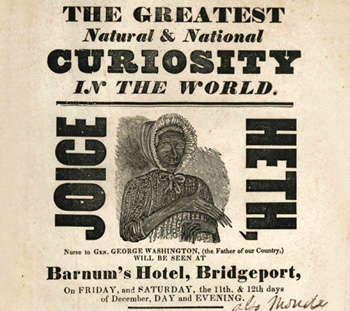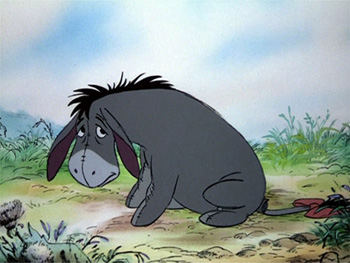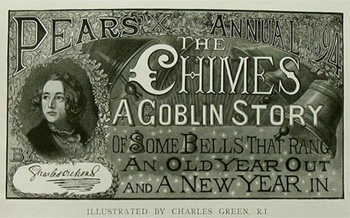5 Wild Scenes Biopics Left Out

Biopics are what happen when filmmakers take a long, hard look at their careers and bellow to nobody in particular "DADDY NEEDS AN OSCAR." In fact, two movies in this article were nominated for a collective four Academy Awards that year. And since winning these things requires a delicate balance between feel-good inspiration and heart-wrenching sentimentality, it's not uncommon for biopics to leave out important historical bits that don't quite fit the formula ...
The Greatest Showman -- P.T. Barnum Launched His Career By Buying An Elderly Slave
If anyone deserves a spot in the BS Artist Hall of Fame, it's P.T. Barnum. The musical Barnum biopic The Greatest Showman shows how he went from humble beginnings to running one of the most popular circus acts in America, long before he ever led the X-Men.
As seen in the movie, Barnum's show featured exotic animals, fake artifacts from around the world, and of course, "freaks," who are more commonly known today as "people." However, like Barnum himself, The Greatest Showman is at best heavily varnished truth, and at worst utter lies. While the movie shows Barnum getting his start with his American Museum, he actually started in show business six years earlier. His first "attraction" was in 1835, when he purchased and exhibited a slave named Joice Heth, whom he claimed was George Washington's childhood nurse and 161 years old.

Heth was blind and paralyzed, but happily told stories about her "dear little George," which gave Barnum dollar signs in his eyes. Slavery was illegal in New York, but Barnum, ever the shrewd businessman, found a loophole that would legally allow him to "rent" a slave, so he paid $1,000 to permanently lease Heth. They toured the northeast, having Heth work 10-12 hours a day telling anecdotes about working for Washington. Which, of course, she never did. When the public figured that out and ticket sales began to slip, an "anonymous" letter was sent to a Boston newspaper claiming that Heth was in fact an automaton, causing a surge in attendance. Apparently, the one thing more popular than an immortal slave is an immortal robot slave.
When Tom Thumb, arguably the most famous Barnum performer, died, Barnum personally paid for a massive monument topped with a life-sized statue to be placed at his grave. When Heth died, on the other hand, Barnum held a public autopsy and charged 50 cents per head. Those people got a front-row seat to the moment when the physician performing the autopsy confirmed that Joice couldn't have been older than 80, and Barnum couldn't be more full of crap.
I, Tonya -- Tonya Harding Saved A Woman's Life, Starred In An Action Movie, Set A Vintage Car Record
If, like us, you lived in constant fear that the post-Millennial generation would grow up without ever knowing what it meant to "Tonya Harding" someone, don't worry. I, Tonya came along and put our worries to rest. The movie stars Margot Robbie as the world-famous figure skater whose career ended after she was convicted for conspiring to bust up her rival's knee. It ends with Harding training for her boxing match against Paula Jones on Fox's Celebrity Boxing show, which sounds like something either we or the movie made up but was painfully real.
Apart from her boxing career and a leaked sex tape in the mid-'90s, Harding more or less fell off the map, so it kinda makes sense to end the movie there. And we say "kinda" because if you saved someone's life, you'd probably expect it to end up in your biopic. In 1996, 81-year-old Alice Olson collapsed at a bar and stopped breathing. Harding jumped in and gave her mouth-to-mouth until paramedics arrived, then presumably skated away into the sunset (only to remember she'd been banned from skating for life). The lady made a full recovery, by the way.
Later that year, Harding was cast in the low-budget movie Breakaway. She played a Mafia associate who tries to split with $300,000 of mob money and is pursued by a hitman played by Joe Estevez, best known as Charlie Sheen's uncle. It's clearly terrible, and is about Tonya kicking the crap out of guys for two hours, which you'd think would be a good fit for someone who was described as one of the most powerful female figure skaters in history. It isn't:
When it became apparent that her acting career wasn't taking off, Harding worked variously as a painter, welder, and hardware salesperson at Sears. She also started collecting and racing classic cars, setting several land speed records for 1931 Model A Fords by getting one up to 97 mph at the Bonneville Salt Flats. This may not sound terribly impressive until you remember that this car has no seat belts and was designed when "highway speed" was 30 mph.
Goodbye Christopher Robin -- The Real Christopher Robin Was Packing Heat
A.A. Milne is best known for writing the Winnie The Pooh books, inspired by his son Christopher Robin's stuffed animals, as well as placing first on any alphabetical list of celebrities. The biopic Goodbye Christopher Robin shows the strained relationship between Milne and Christopher, which is what happens when your dad cashes in on your childhood (as the real Dennis the Menace also knew very well).
What the movie doesn't show is Christopher's almost supernatural knack for mechanical objects, such as taking apart his nursery lock when he was seven and building a working grandfather clock out of a Meccano set (a British Erector set, basically). His crowning achievement, however, was when he was ten and noticed that his toy cap gun was essentially a real gun that had the barrel blocked and modified to only fire blanks. Being the industrious child he was, Christopher immediately filed off the tip of the barrel and then went to his ammo guy (he legitimately had an ammo guy), loaded his cap gun with real bullets, and proceeded to nearly blow his hand off.
Luckily, the damage wasn't serious, so Christopher had his ammo guy drill out the gun's barrel so a bullet could fit down it. From then on, Christopher wandered through the town and Hundred Acre Wood packing heat, even though he admitted the gun wasn't very accurate (the only thing worse than a child wielding a handgun is a child wielding a handgun with no idea where the bullet will go). Christopher's father was totally aware of this, by the way, and even shot the gun himself. He only made Christopher destroy it when he heard about another child accidentally shooting themselves, a possibility that had evidently never previously occurred to him.

While the adult Christopher maintained a cordial if distant relationship with his dad, his mom more or less disowned him, refusing the see him even on her deathbed. What was Christopher's terrible crime? He married his first cousin ... whose dad Mrs. Milne hated. So she responded by hating her son too and not speaking to him for years. If your only criteria for your son's wife is "Don't marry THAT cousin," you might have your priorities out of whack.
The Man Who Invented Christmas shows how a struggling Charles Dickens overcame writers' block (and, according to this movie, schizophrenia-induced hallucinations) to create his best-known work, A Christmas Carol. It's a funny, touching, and inspiring story.
Less funny, touching, and inspiring is what Dickens did next. Determined to keep the gravy train rolling, he decided to publish another Christmas novel the following year. He called it The Chimes, or to use its proper name, The Chimes: A Goblin Story Of Some Bells That Rang An Old Year Out And A New Year In.

The Chimes is the story of "Trotty" Veck, who believes that poor people are inherently bad, despite being poor himself. One night, he is drawn to the bell tower of his local church, where he finds a group of goblins who inform him that he fell while climbing there, and is now dead. They then show him what would happen to all the people in his life if Trotty wasn't there, until Trotty finally has a revelation and says he has learned his lesson. He wakes up the next day in bed, a changed man. If you think this sounds a lot like A Christmas Carol, you're wrong, because A Christmas Carol takes place on Christmas, while The Chimes takes place at New Year's. Duh.
The Chimes is polarizing, with many viewing it as an obvious cash-in on A Christmas Carol, while reviewers of the day considered it dangerously radical for suggesting that poor people aren't evil. Despite some initial success, The Chimes eventually slipped beneath the waves to join Crystal Skull and Caddyshack 2 in the abyss of best-forgotten sequels. So we're probably not getting a behind-the-scenes movie for that one, we're guessing.
The Man Who Brought Down The White House -- "Deep Throat" Once Suggested Kidnapping A Baby
Mark Felt: The Man Who Brought Down The White House is the story of how Mark Felt ... did that, pretty much. In the '70s, Felt, the second-highest-ranking official in the FBI, became a whistleblower for The Washington Post, leaking details of the Watergate scandal, which eventually led to President Richard Nixon's resignation. It's probably the second most thrilling movie starring someone nicknamed "Deep Throat."
However, the film doesn't cover other, less heroic parts of Felt's career, such as his involvement in COINTELPRO, a super evil series of investigations ordered by J. Edgar Hoover on anyone he felt was "subversive" (i.e. not actively fellating the government). Felt was tasked with investigating the revolutionary group Weather Underground, which had carried out several bombings around the US in the '60s and '70s. Felt authorized a number of warrantless searches (more commonly known as "breaking and entering") of suspected WU members and their families, including children. Especially children. Felt decided that the best way to draw the WU leaders out of hiding was to friggin' kidnap their infant niece. The plan never succeeded, but when leaked documents revealed the plot, prosecutors decided giving the Undergrounders a light plea deal would be easier than trying to justify kidnapping to a jury. Bill Ayers had all charges dropped and Bernardine Dohrn got away with a year of probation, which you might recognize as not bad for domestic terrorism.
Felt defended his actions and said he would have done it again. Unsurprisingly, he was convicted of illegal searches / being a supervillain, despite Richard Nixon testifying that presidents ordered illegal break-ins, like, all the time, and it was totally not a big deal, you guys. Nixon also, ironically, contributed to Felt's defense fund. Felt was eventually pardoned by President Reagan, punctuating a ridiculous period of American history when everyone was doing bad stuff and nobody learned anything.
Winnie The Pooh was still at his greatest in The Search For Christopher Robin, don't @ us.
If you loved this article and want more content like this, support our site with a visit to our Contribution Page. Please and thank you.
For more check out 7 Oscar-Nominated 'True Story' Movies (Are Based On Lies) and Famous Biographical Movies That Are Shockingly Full Of Lies.
Also, follow us on Facebook, and we'll follow you everywhere.